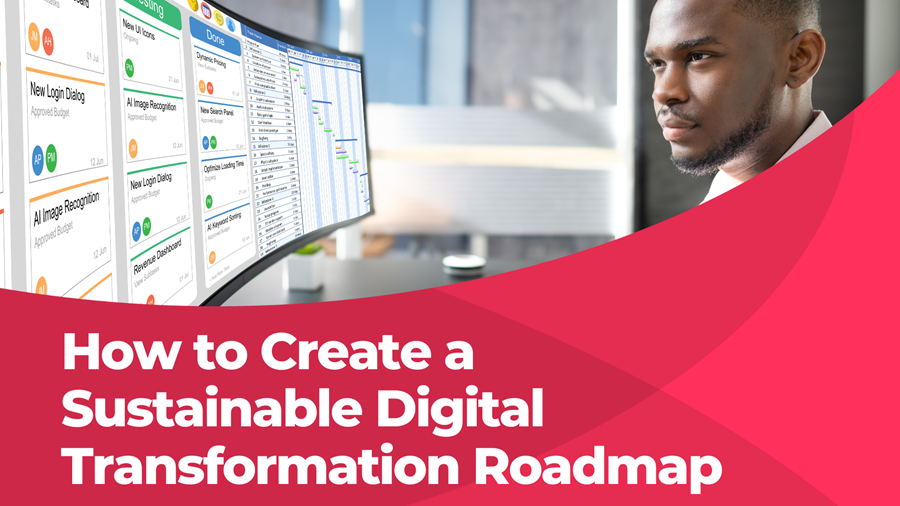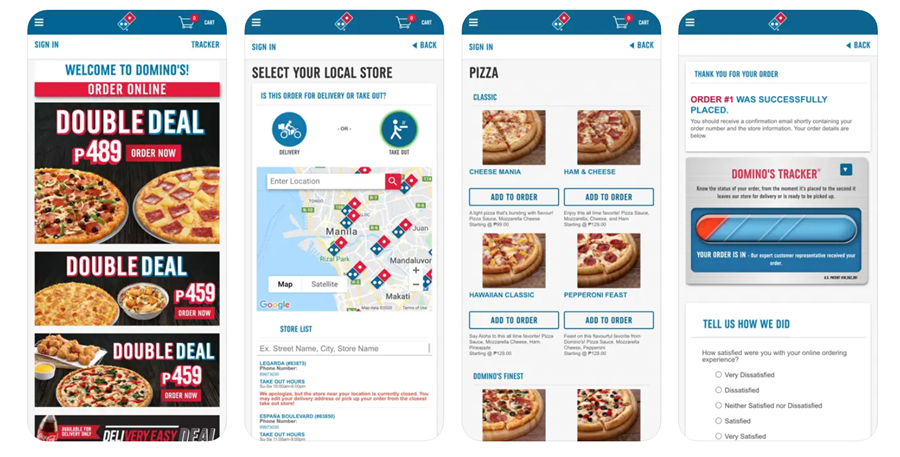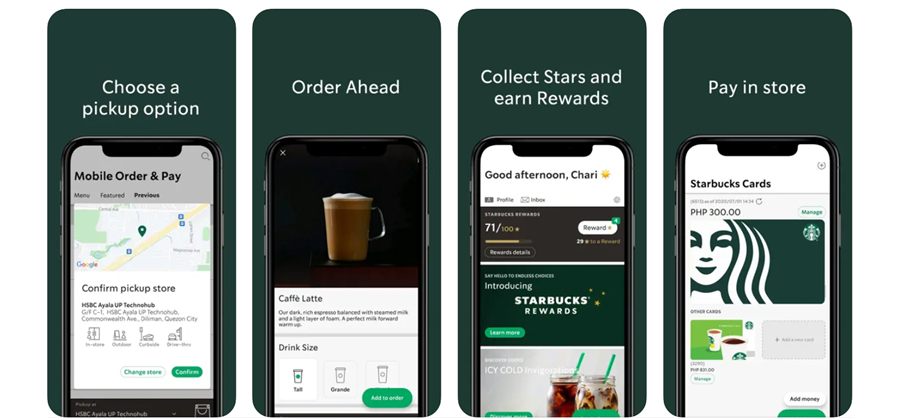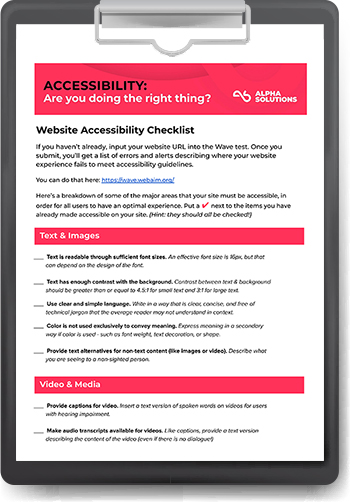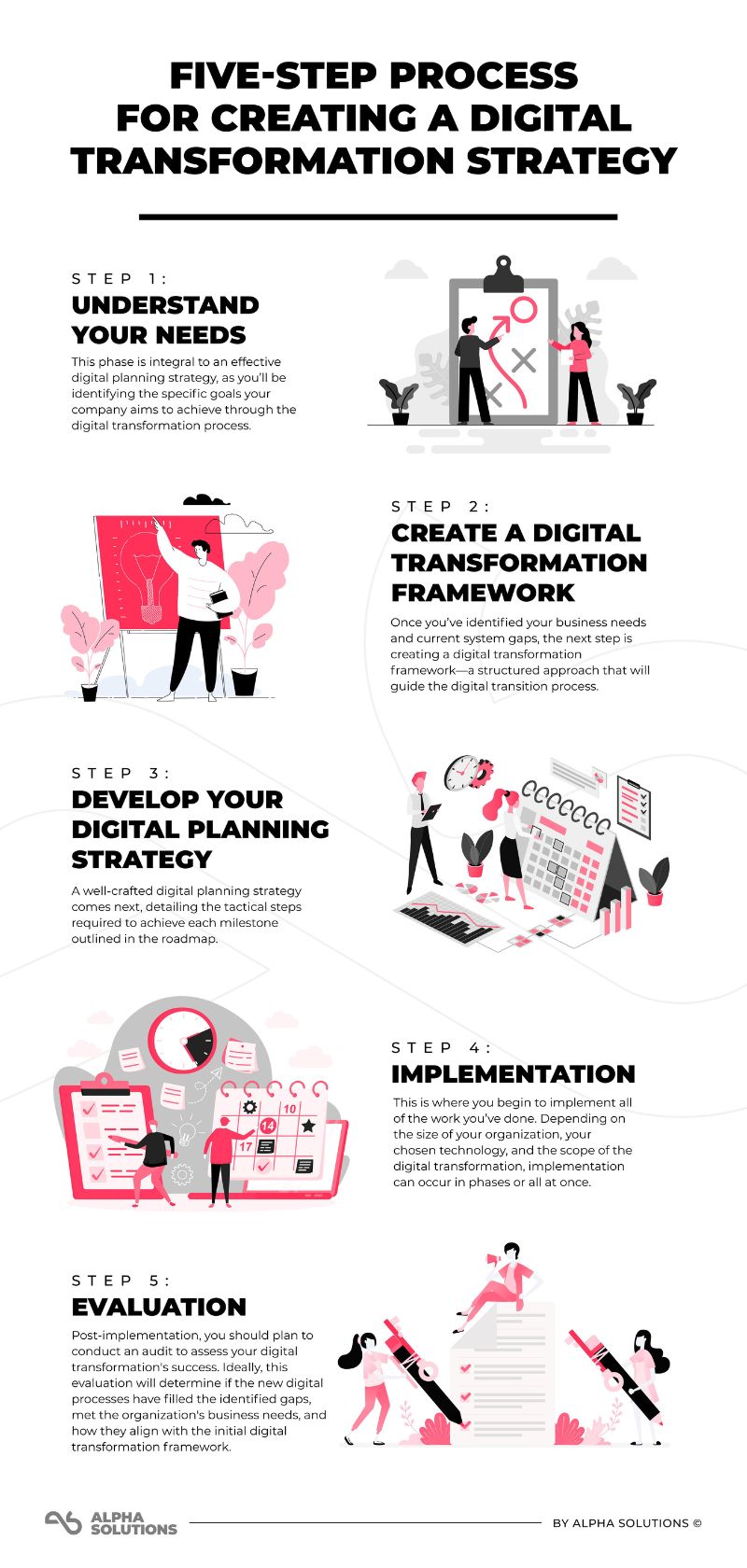Sears, Nokia, Kodak, 🦕… in an ever-evolving world, businesses must consistently adapt their digital roadmap and operational structures to survive and remain competitive.
A pivotal component of successful digital transformation means migrating existing processes to new, more efficient systems.
In this article, we’ll explore how you can strategically map out the journey of your digital transformation.
We’ll walk you through…
…understanding your business needs
…identifying gaps in the current system
…effectively creating a digital transformation framework, roadmap, and planning strategy.
Before we get into all of that, how about some inspiration?
Let’s look at a few real world examples of brands that have successfully LEVERAGED a digital planning strategy to transform their operations and improve business outcomes.
(Spoiler: Blockbuster and RadioShack are not on this list.)
🍕 Domino's Pizza
One of the most renowned examples of a successful digital transformation is Domino's Pizza. Struggling with a declining slice of the proverbial pie, Domino's adopted a digital-first approach, effectively overhauling its operations.
Their digital planning strategy involved:
-
Developing a mobile app for easy ordering
-
Using AI for delivery optimization
-
Introducing a pizza tracking system
-
Using data analytics to understand customer preferences
These digital initiatives have transformed Domino's into a tech company that sells pizza, contributing significantly to a rebound in sales and meatier margins.
🔅 Walmart
In response to increasing e-commerce competition (especially Amazon), the brick-and-mortar Walmart of old days implemented a comprehensive digital planning strategy to future-proof its footprint.
The retail giant made the following changes:
-
Developed a robust online marketplace
-
Upgraded its mobile app
-
Integrated AI for improved inventory management
-
Launched an online grocery service
These changes were driven by a clear understanding of customer needs and a strategic roadmap for digital transformation.
Today, Walmart is standing strong against its Amazon warriors in an ultra competitive online sales jungle.
👟 Nike
Brand darling Nike, always at the forefront of technology in its athletic apparel and sporting goods, has embraced digital transformation to also enhance customer engagement and increase sales.
Their digital planning strategy involved:
-
Developing mobile applications (Nike App, Nike SNKRS, Nike Run Club)
-
Using AR technology for virtual shoe trials
-
Leveraging big data for personalized “Just Do It” customer experiences
Nike's strategic digital initiatives have significantly increased its direct-to-consumer sales, reinforcing its brand position. Swoosh!
🧑🍳 General Electric (GE)
Source: officesnapshots.com
GE underwent a massive digital transformation to enhance operational efficiency.
They developed an industrial internet platform, Predix, to collect and analyze data from industrial machines, increasing productivity and reducing costs.
Furthermore, GE established a new division, GE Digital, highlighting the brand's “appliance” of a strategic focus on digital transformation.
🧋 Starbucks
Starbucks has consistently been a leader of the digital revolution in the food and beverage industry.
Their digital transformation roadmap included:
-
A successful mobile payment and order system
-
A personalized loyalty program
-
AI-powered drive-thrus
The entire Starbucks' digital planning strategy, focusing on improving customer experience, has contributed significantly to its venti success in the digital era.
All of these brands have effectively used a digital planning strategy to transform their business operations, demonstrating the power of a well planned digital transformation.
They successfully…
… identified their business needs
… made use of technology to fill operational gaps
… and redefined their customer experience.
In doing this, these companies have set an incredibly high standard of digital transformation for the rest of us. (Thanks guys.)
While we could go on all day, sharing successful stories of digital transformation, not every company's efforts are quite as “fruitful”. (cough - BlackBerry - cough)
Here are some examples of brands that STRUGGLED with their digital planning strategies:
📸 Kodak
Kodak's fall is a prime example of a brand that’s out of the picture due to a failed digital transformation. Despite literally inventing the digital camera, Kodak failed to capitalize on the technology due to their over-reliance on film-based revenues.
They delayed launching their digital strategy and when the shift finally happened, it was too late.
Kodak failed to “develop” an effective digital planning strategy that could keep up with rapidly changing market dynamics, resulting in bankruptcy in 2012.
📼 Blockbuster
Blockbuster was once a giant in the video rental industry. (Remember when we had a video rental industry?) However, they were too late to board the digital transformation train and failed to create an effective digital planning strategy.
Despite the opportunity to buy Netflix, they focused on their brick-and-mortar stores, dismissing the potential of online streaming services. (If only they could be kind and rewind… all the way Back To The Future 🛹)
As Netflix and other streaming services grew, Blockbuster's market share dwindled, leading to bankruptcy.
👗 Sears
In 1969, Sears was the largest retailer in the world, with sales representing 1% of the American economy. However, Sears (astonishingly) failed to implement a digital planning strategy.
Despite fleeting attempts at improving online sales and boosting digital integration, they were too late. Sears lost footing and couldn’t compete with digitally-savvy competitors like Amazon and Walmart (see above).
A lack of focus on digital customer experience and late adoption of e-commerce contributed to their decline.
☎️ Nokia
In its glory days, Nokia was the world's largest vendor of mobile phones. While the company still makes phones, we don’t know anyone who has one, making this another example of a failed digital planning strategy.
Despite having the resources and capabilities, Nokia was simply too slow to adapt to the rise of smartphones and app ecosystems.
Their inability to recognize and plan for the digital “flip” cost them their market dominance. The digital transformation plan at Nokia is broke-ia.
📟 BlackBerry
Developed by a small Canadian tech company, BlackBerry was a pioneer in the evolution of smartphones. However, they failed to foresee the demand for user-friendly, app-based smartphones, a shift led by Apple's iPhone and Android devices.
The BlackBerry digital planning strategy was rigid and didn't consider the need for a robust app ecosystem and touch interface.
You simply can’t compare Apples to BlackBerrys. While the company still exists (😲), it no longer makes smartphones.
|
How accessible is your website? Get our free accessibility checklist to guide your efforts for getting compliant and doing the right thing. Plus, receive real feedback from us to help you on your next steps. |
An effective digital planning strategy is crucial for companies that want to stay relevant.
Missteps in digital planning strategy can lead to giant missed opportunities, declining market share, public humiliation, and even bankruptcy.
These brands serve as reminders that digital transformation isn't just about adopting technology; it requires a comprehensive, forward-looking strategy that aligns with market trends and keeps up with customer demands.
How do you create a digital transformation strategy that will keep you in the lead?
Who better to ask than Alpha Solutions?
Here’s our five-step process for creating a digital transformation strategy:
STEP 1: UNDERSTAND YOUR NEEDS
The first step in a digital transformation journey involves understanding the organization's business needs.
This phase is integral to an effective digital planning strategy, as you’ll be identifying the specific goals your company aims to achieve through the digital transformation process.
Are you looking to:
…improve customer experience?
…boost operational efficiency?
…increase profitability?
Clear definition of your end goals will help shape the overall digital transformation framework and determine the subsequent steps of your transformation roadmap.
Regardless of your goals, an in-depth analysis of current business processes will form the bedrock of your digital planning strategy.
Each operational process must be scrutinized to understand its function, efficiency, and interdependencies.
This analysis will highlight inefficiencies, bottlenecks, and gaps that digital transformation can address.
STEP 2: CREATE A DIGITAL TRANSFORMATION FRAMEWORK
Once you’ve identified your business needs and current system gaps, the next step is creating a digital transformation framework—a structured approach that will guide the digital transition process.
This framework should detail the path from your current state to the desired future state, including:
-
the various milestones you’ll need to hit
-
critical tasks to be completed
-
detailed individual responsibilities
-
expected outcomes.
Your digital transformation framework is the backbone of your digital transformation journey, providing a structured, repeatable approach to guide decision-making and actions.
An essential part of the digital transformation framework is the digital transformation roadmap. This roadmap is a strategic document outlining the steps, timelines, and resources required to meet the digital transformation objectives.
A roadmap should be flexible, accommodating changes that may occur during the transition process, yet robust enough to provide clear direction.
Each element of the roadmap should correlate directly to the business needs identified earlier, ensuring that the digital transformation aligns with your company’s strategic objectives.
The roadmap should also consider the identified gaps in your current system, highlighting digital solutions that will address those deficiencies.
Your digital transformation roadmap should serves as a guidepost for all stakeholders, helping them understand your desired transformation's scale, complexity, and the benefits they can expect as a result.
STEP 3: DEVELOP YOUR DIGITAL PLANNING STRATEGY
A well-crafted digital planning strategy comes next, detailing the tactical steps required to achieve each milestone outlined in the roadmap.
This strategy requires a keen understanding of the digital landscape and your organization's capabilities and challenges.
Your digital planning strategy should highlight:
-
Tasks to be performed
-
The technology to be used
-
Who is responsible
-
How success will be measured
If your brand isn't already using composable technology, making the switch will make your digital transformation much easier.
What is composable technology?
Composable technology, also known as composable infrastructure, is an IT framework that treats compute, storage, and network devices as pools of resources that can be pulled from as needed, depending on an applications requirements.
This approach is highly adaptive and offers significant flexibility—both crucial components of a successful digital transformation journey.
Here's how composable technology can aid in creating your digital transformation map:
✅ Greater Agility. Composable technology brings unprecedented agility to IT infrastructure. The ability to dynamically reconfigure hardware resources based on the needs of an application allows businesses to quickly adapt to changes, speeding up the deployment of new services and applications.
This agility aligns perfectly with the dynamic needs of a digital transformation map, allowing businesses to pivot and change course as necessary.
✅ Increased Efficiency. Composable infrastructure operates on the principles of hyper-efficiency. By allowing hardware resources to be precisely allocated to match application needs, businesses can maximize utilization and avoid over-provisioning, reducing costs and enhancing operational efficiency.
In a digital transformation journey, this efficiency translates into more resources for innovation and growth.
✅ Super Scalability. The scalability offered by composable technology is a significant enabler for digital transformation. As business needs grow, so can the infrastructure without major overhauls or additional investments.
This scalability helps maintain the momentum of the digital transformation, ensuring that progress is not hindered by resource limitations.
✅ Intelligent Automation. Composable infrastructure leverages software-defined intelligence and automation, allowing for the management of infrastructure through code.
This automation can dramatically speed up processes, reduce human error, and free up IT staff to focus on strategic aspects of the digital transformation.
✅ Smooth Integration. Composable technology seamlessly integrates with existing infrastructure and is designed to work with a diverse range of applications and services, making it a perfect fit for a multi-faceted digital transformation strategy.
This smooth integration supports a complex digital transformation strategy, allowing different elements to work together without friction or compatibility issues.
✅ High Innovation. By reducing time spent on managing and provisioning resources, composable infrastructure allows IT teams to focus on innovative projects aligned with the digital transformation roadmap.
This enhances the potential for growth and exploration of new technological avenues, advancing the business’s overall transformation journey.
As you can see, composable technology aligns with the core principles of a digital transformation map—agility, efficiency, scalability, and innovation. It provides a flexible and adaptive infrastructure that can accelerate the digital transformation process, allowing businesses to stay competitive in the digital era and beyond.
However, merely developing a digital planning strategy and adopting the right technology to deploy it is not enough.
Your strategy needs to be backed by a strong change management plan because the transition to digital processes often involves a significant shift in operations, organizational culture, and employee roles.
Change management will help make this transition smooth, ensuring all stakeholders are prepared and supportive of the changes ahead.
STEP 4: IMPLEMENTATION
This is where you begin to implement all of the work you’ve done. It’s the step where planning and strategy translate into action.
Depending on the size of your organization, your chosen technology, and the scope of the digital transformation, implementation can occur in phases or all at once.
Regardless, regular monitoring is crucial during this phase to ensure alignment with the digital transformation roadmap and to make necessary adjustments.
STEP 5: EVALUATION
Post-implementation, you should plan to conduct an audit to assess your digital transformation's success.
Ideally, this evaluation will determine if the new digital processes have filled the identified gaps, met the organization's business needs, and how they align with the initial digital transformation framework. Depending on the results, you will continue to adjust and iterate.
Remember, digital transformation is not a “one and done” exercise. Plan to review how things are going on a regular basis.
Conclusion
The journey of migrating existing processes to digital processes requires strategic planning and a thorough understanding of business needs and system gaps.
By developing a robust digital transformation framework, creating a comprehensive digital transformation roadmap, and following a meticulous digital planning strategy, businesses can successfully navigate the complexities of this transition.
Brands that take these steps are more likely to enjoy improved efficiency, higher productivity, and a competitive edge in the digital age and whatever comes next.
At Alpha Solutions, we’d be happy to help with your digital transformation plan to keep you in the game. Contact us today to learn more.


